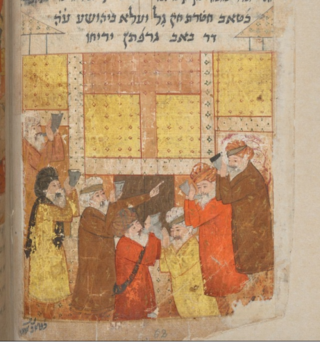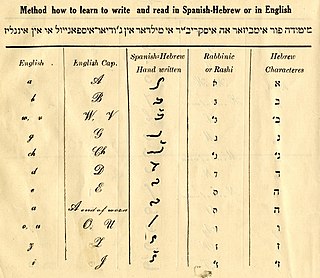Related Research Articles

The Romaniote Jews or the Romaniotes are a Greek-speaking ethnic Jewish community native to the Eastern Mediterranean. They are one of the oldest Jewish communities in existence and the oldest Jewish community in Europe. The Romaniotes have been, and remain, historically distinct from the Sephardim, some of whom settled in Ottoman Greece after the expulsion of Jews from Spain and Portugal after 1492.
Knaanic is a tentative name for a number of West Slavic dialects or registers formerly spoken by the Jews in the lands of the Western Slavs, notably the Czech lands, but also the lands of modern Poland, Lusatia, and other Sorbian regions. They became extinct in the Late Middle Ages. Very little is known about their difference from the surrounding Slavic languages. The largest number of samples of Knaanic written in Hebrew script are in Czech; therefore, most commonly Knaanic is associated with Old Czech.

Judeo-Persian refers to both a group of Jewish dialects spoken by the Jews living in Iran and Judeo-Persian texts. As a collective term, Judeo-Persian refers to a number of Judeo-Iranian languages spoken by Jewish communities throughout the formerly extensive Persian Empire, including the Mountain and Bukharan Jewish communities.

Jewish languages are the various languages and dialects that developed in Jewish communities in the diaspora. The original Jewish language is Hebrew, supplanted as the primary vernacular by Aramaic following the Babylonian exile. Jewish languages feature a syncretism of Hebrew and Judeo-Aramaic with the languages of the local non-Jewish population.

Judeo-Arabic dialects are ethnolects formerly spoken by Jews throughout the Arab world. Under the ISO 639 international standard for language codes, Judeo-Arabic is classified as a macrolanguage under the code jrb, encompassing four languages: Judeo-Moroccan Arabic (aju), Judeo-Yemeni Arabic (jye), Judeo-Iraqi Arabic (yhd), and Judeo-Tripolitanian Arabic (yud).
Judeo-Italian is an endangered Jewish language, with only about 200 speakers in Italy and 250 total speakers today. The language is one of the Italian languages and one of the Jewish Romance Languages. Some words have Italian prefixes and suffixes added to Hebrew words as well as Aramaic, roots. All of the language's dialects except one are now extinct.
Sephardi Hebrew is the pronunciation system for Biblical Hebrew favored for liturgical use by Sephardi Jews. Its phonology was influenced by contact languages such as Spanish and Portuguese, Judaeo-Spanish (Ladino), Judeo-Arabic dialects, and Modern Greek.
Yevanic, also known as Judaeo-Greek, Romaniyot, Romaniote, and Yevanitika, is a Greek dialect formerly used by the Romaniotes and by the Constantinopolitan Karaites. The Romaniotes are a group of Greek Jews whose presence in the Levant is documented since the Byzantine period. Its linguistic lineage stems from the Jewish Koine spoken primarily by Hellenistic Jews throughout the region, and includes Hebrew and Aramaic elements. It was mutually intelligible with the Greek dialects of the Christian population. The Romaniotes used the Hebrew alphabet to write Greek and Yevanic texts. Judaeo-Greek has had in its history different spoken variants depending on different eras, geographical and sociocultural backgrounds. The oldest Modern Greek text was found in the Cairo Geniza and is actually a Jewish translation of the Book of Ecclesiastes (Kohelet).
Zarphatic, or Judeo-French, is an extinct Jewish language that was spoken by the French Jews of northern France and in parts of west-central Germany, such as Mainz, Frankfurt am Main and Aix-la-Chapelle. It was also spoken by French Jews who moved to Norman England. Some have conjectured that the language influenced the development of Yiddish.

Judeo-Malayalam is the traditional language of the Cochin Jews, from Kerala, in southern India, spoken today by a few dozens of people in Israel and by probably fewer than 25 in India.
Judaeo-Romance languages are Jewish languages derived from Romance languages, spoken by various Jewish communities originating in regions where Romance languages predominate, and altered to such an extent to gain recognition as languages in their own right. The status of many Judaeo-Romance languages is controversial as, despite manuscripts preserving transcriptions of Romance languages using the Hebrew alphabet, there is often little-to-no evidence that these "dialects" were actually spoken by Jews living in the various European nations.
Judaeo-Catalan, also called Catalanic or Qatalanit, was a presumed Jewish language spoken by the Jews in Northern Catalonia and what is today Northeastern Spain, especially in Catalonia, Valencia and the Balearic Islands.

Solitreo is a cursive form of the Hebrew alphabet. Traditionally a Sephardi script, it is the predecessor of modern cursive Hebrew currently used for handwriting in modern Israel and for Yiddish. The two forms differ from each other primarily in that Solitreo uses far more typographic ligatures than the Modern Hebrew script.

Haketia is an endangered Jewish Romance language also known as Djudeo Spañol, Ladino Occidental, or Western Judaeo-Spanish. It was historically spoken by the North African Sephardim in the Moroccan cities of Tétouan, Tangier, Asilah, Larache, Chefchaouen, Ksar el-Kebir, and the Spanish towns of Ceuta and Melilla. Tetuani Ladino was also spoken in Oran, Algeria. One of the distinctions between Ladino and Haketia (Haquetia) is that the latter incorporates Arabic.
Baghdad Jewish Arabic or autonymhaki mal yihud or el-haki malna is the variety of Arabic spoken by the Jews of Baghdad and other towns of Lower Mesopotamia in Iraq. This dialect differs from the North Mesopotamian Arabic spoken by Jews in Upper Mesopotamian cities such as Mosul and Anah. Baghdadi and Northern Mesopotamian are subvarieties of Judeo-Iraqi Arabic.

Judaeo-Spanish or Judeo-Spanish, also known as Ladino, is a Romance language derived from Old Spanish.
Eastern Sephardim are a distinctive sub-group of Sephardic Jews mostly descended from Jewish families which were exiled from Iberia in the 15th century, following the Alhambra Decree of 1492 in Spain and a similar decree in Portugal five years later. This branch of descendants of Iberian Jews settled across the Eastern Mediterranean.
Judeo-Gascon is a sociolect of the Gascon language, formerly spoken among the Spanish and Portuguese Jews who settled during the 16th century in the cities of Bordeaux, Bayonne and in the south-west part of Landes of Gascony (most notably in Peyrehorade and Bidache. Judeo-Gascon, as Judeo-Provençal, the other major Jewish sociolect of Occitan, is now practically extinct.
Judeo-Livornese/Baggito (Italian: Giudeo-Livornese/Bagitto) is an extinct dialect of the Judeo-Italian languages, historically spoken by the Jewish community in and around Livorno. It was heavily influenced by Judeo-Portuguese, Judeo-Italian, Ladino. It is best attested through the works of Guido Bedarida.
References
- 1 2 "Significado de judeo-português". Archived from the original on 2016-03-03. Retrieved 2023-05-23.
- ↑ Silva, Luiz Antônio da (org.) (2005). A língua que falamos: português, história, variação e discurso. Rio de Janeiro: Globo. p. 212.
- 1 2 3 4 Toledo, Selin (2018-10-27). "Ladino's Lost Sibling". Medium. Retrieved 2023-12-22.
- 1 2 3 4 5 "Judeo-Portuguese". Jewish Languages. Retrieved 2023-12-22.
- ↑ Jewish and Non-Jewish Creators of "Jewish" Languages. Wiesbaden. 2006. p. 466. ISBN 3-447-05404-2.
- Judaeo-Portuguese in Jewish Language Research Center
- Thesouro dos Dinim, a halakhic work (annotated transcription) Archived 2011-09-27 at the Wayback Machine
- Thesouro dos Dinim, a halakhic work (partial facsimile)
- Menasseh Ben Israel de la fragilidad humana y inclinacion del hombre al peccado. Parte primera
- Strolovitch, Devon L. (2005) Old Portuguese in Hebrew Script: Convention, Contact, and Convivência. Ph.D. dissertation, Cornell University, Ithaca, NY.